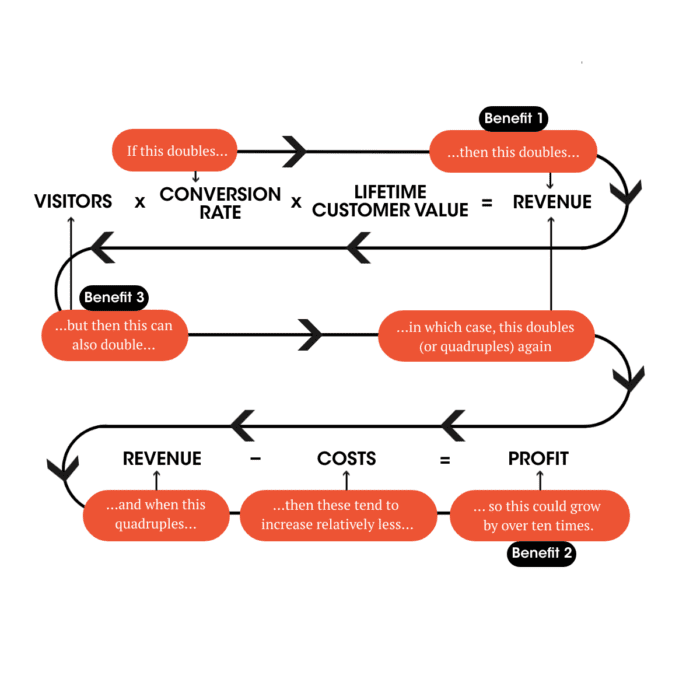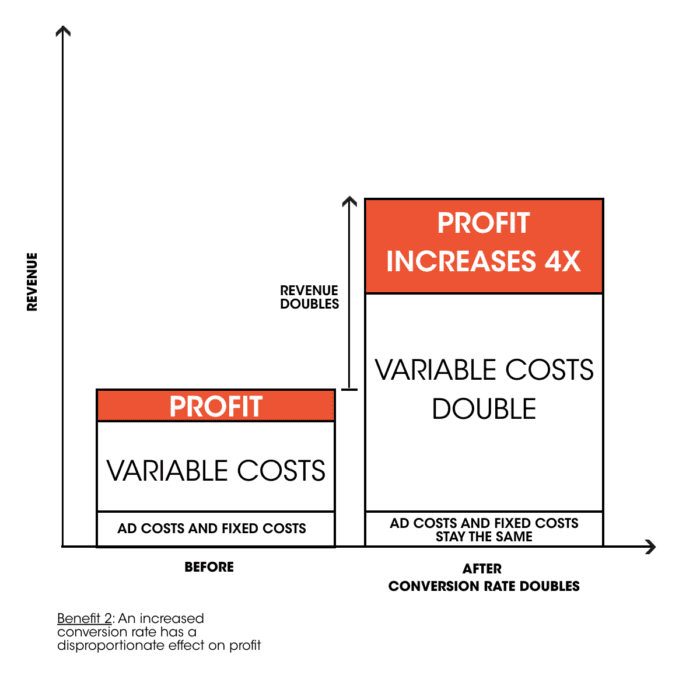It’s quite simple, really. Doubling, even quadrupling your ad revenue is easily achievable if you know how to leverage conversion rate optimization (CRO).
Quick jump to:
What is conversion rate optimization?
How does conversion rate affect revenue and profitability?
How to double your conversion rate
I doubled my conversion rate, now what?
Spend less, increase retention
What is conversion rate optimization?
Conversion rate optimization can be defined as the practice of augmenting the percentage of users performing a sought-out action on a website. Desired actions can take several shapes such as:
- Purchasing a product
- Downloading a file
- Clicking “Add to cart”
- Subscribing to a newsletter
- Signing up for a service
- Filling out a form
- Clicking a link.
It’s important to first note that your website is also your product, regardless of whether you’re selling goods or services. Understandably, many businesses tend to invest first in paid media to generate faster traffic and results. Yet, traffic, or visitors, will always be there for the taking. Instead, the priority needs to pivot towards CRO, ensuring that users have a good experience on your website, and only then, should a business start thinking about generating a bigger volume of visitors, now profitable visitors. Imagine advertising to people to come into a grocery store that deceptively sells rotten food. There will always be visitors, but once they realize the food is spoiled, they won’t buy it and most likely will not return.
In this article, we’ll prove the power of CRO with a simple and straightforward equation. By breaking down all variables, each of which combined will logically and ultimately lead your digital marketing strategy towards greater profit.
How does conversion rate affect revenue and profitability?
First, let’s take a look at the equation1:

Notice how it addresses the first variable, conversion rate. If it doubles, it will trigger a domino effect positively improving all other variables, leading to profitable end results. It is therefore essential not to undermine the impact that conversion rate has on the rest of your ad strategy. In other words, if you’re able to increase your conversion rate, you’re on the path to growth.
Yet, the question remains:
How does one double its conversion rate?
This is when user experience (UX) comes into play. When you start improving your user experience, you’re increasing your chances of a lead converting. Here are four key elements to keep in mind when reevaluating or reconstructing your online user experience.
1. Apply customer-centric design to your website.
A reason why your website might not be converting is because of its design. Is it straight-to-the-point? Are the colors and buttons at the right places? Are you using the best call-to-actions? Aesthetics aren’t enough to maintain a customer’s attention, you need to test and retest all creatives until you’ve found the most converting version of your website.
2. Ensure continuity between your ad and your website.
A common occurrence when launching an ad is the disconnect between the ad’s messaging, purpose, and branding and those of its intended landing page. A sure way to lose a lead as it clicks on an ad, is to have the associated landing page be completely different than what was expected. Align your ad campaign’s value and offer with your website’s landing pages, from colors to CTAs, to the actual product or service being delivered.
3. Know your audience.
Often, companies believe they know what their website visitors are thinking and looking for. But that’s just it – they’re assuming. In reality, the point of your website might go completely over a user’s head, your website might be confusing, or even make your company look untrustworthy.
Use the tools at your disposal to get a better grasp on what a user is going through when visiting your website:
- Basic behaviour analytics
- Heatmaps
- User research (remote testing of focus groups)
- On-site surveys
4. Start and don’t stop A/B testing.
Why rely on your gut when A/B testing tells the truth? With the feedback and data you’ve gathered from your visitors, start changing, updating and retesting your website. Once you’ve done your first A/B test, you’re already in a better place than you were before, most likely already converting at a higher rate. Next thing you know, you’ve doubled your conversion rate.
Back to our Equation
Now that you have the tools to double your conversion rate, the CRO equation gets put into action and you can start reaping the benefits. With a doubled conversion rate, you’ll also see a doubled revenue.
But what if you could quadruple your revenue? Then it’s time to take a look at your second variable: visitors. With a higher revenue, you can now invest in other marketing initiatives that will attract quality leads. Also, an overall better user experience will have a positive impact on other channels like Search Engine Optimization. You’ll probably attract more organic traffic, therefore increasing the number of visitors.
With more visitors and a better conversion rate, your revenue will once again grow.
Finally, once your revenue has doubled, as seen in the graph below2, your costs will start to increase relatively less, resulting in a fast-growing profit.

By delivering a better user experience, you’re relying less on spending money on ads to reach your goals. You’re instead relying on free traffic from search engines, allowing you to use different channels simultaneously. If you’re spending ad money just to keep up with competitors, you’re probably not taking full advantage of what your website can deliver to users.
The Cherry on Top
By optimizing your conversion rate, you’re also optimizing your long-term relationship with your customers. Looking at the equation, you’ll notice a third variable, the customer lifetime value. As the user experience increases, so does the conversion rate, at which point the aforementioned benefits come into play. In the end, however, an improved UX will also encourage a healthy retention rate, and, in turn, a better customer lifetime value. In other words, the more customers who come back to your website due to a good UX, the less you have to spend on acquiring new leads, ultimately doubling your revenue over time.
Final Thoughts
It is possible for all companies, big or small, B2C or B2B, to double, even quadruple their ad revenue using UX best practices and conversion rate optimization. We hope this article was able to illustrate the cost-effectiveness of scaling on the UX portion of a business’ digital assets and proved how much CRO can be a huge lever for success.
Need help getting started on your CRO strategy? Reach out to us!
Subscribe to The Shift Factor
Our newsletter keeps you in the know on marketing’s biggest shifts and real examples of brands adapting.




Share this: